It’s probably no surprise by now that we here at The Journal have a soft spot for collages. Perhaps it’s the suggested but elusive narrative. Perhaps it’s that pastiche most accurately portrays what living in the world of today is like. Perhaps it’s because they’re just fun. The collages of David Dodd Lee are all of the above: witty, self-aware but not self-concerned, ready at once to comment on life and at the same time simply exist. Art Editor Morgan Fox interviewed David on the paradoxical nature of collage.
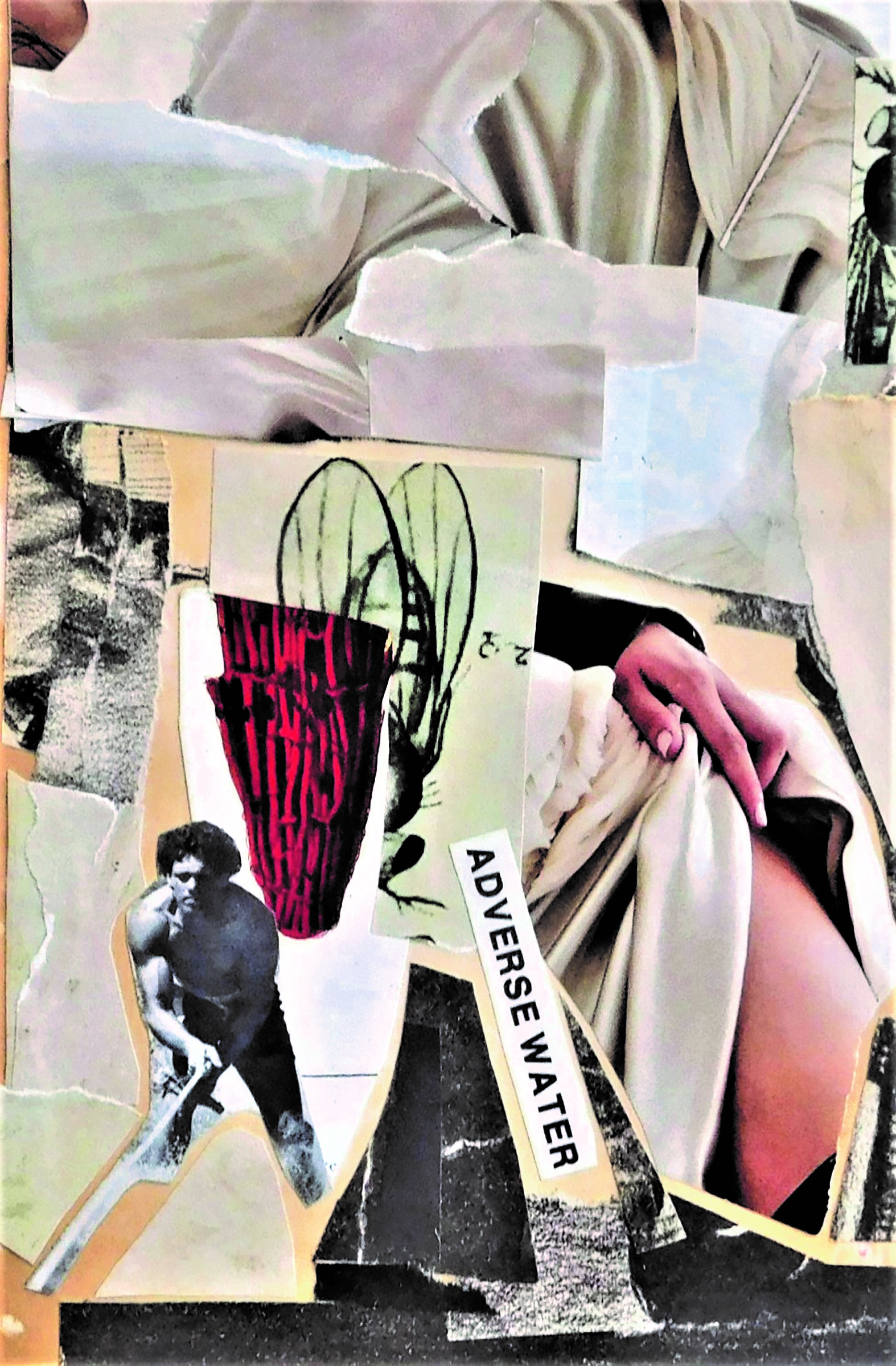
adverse water
Morgan Fox: I always ask this, because I love the technical nature of making art, but it always feels a little weird to ask this of collagists, considering collage is really a matter of chance, but could you talk a little bit about your process?
David Dodd Lee: Process, ideally, becomes that meditative state you enter while making your art. The goal is to BE perpetually part of it (the art). I wake, decide what my priorities for the day will be, often opt to enter the nowhereness of making choices as to form and content. It’s in this realm that language and objects can become (or be made to become) defamiliarized. You become immersed in this world of your own making, so to speak. I’m making quite a leap here, but at this point my art-making is more about my art-making than it is about anything else, than about, for instance, politics or culture. This isn’t to say making art is somehow without drama. The journey is one in which much of the pleasure comes from breaking out of whatever habits one has most recently developed in an attempt to place elements together in some up-until-now never-before-seen way. You are, of course, subliminally echoing the art of artists you’ve loved your whole life to some degree (today, that feels most like Marlene Dumas, Albert York, Agnes Martin, and Albert Oehlen). Case in point, I am miles from the artist I was as a youngster, who drew what I saw in the world in order to transcend the self, in order, in other words, to merge with the essence of the bird I was drawing (I drew a lot of wildlife). By twenty-five, I’d gone mostly abstract (mostly as a painter). And by my late twenties I’d begun to write fiction and poetry. I did not make a whole lot of art in the late 80s and 90s. But when I did return to it I was also erasing poems (I’ve published two books of Ashbery erasures). It felt as natural to suddenly begin making collages at that point as it had, earlier, when I’d begun to write at the same time I was making large abstract paintings. The collages I began making around 2007 were spontaneous and extremely messy. I was determined to make art that was a confusion of cultural detritus, crap all over the place, with only the merest hint of harmonization of visual elements present. Right away, I was pushing back against what I once described as the hegemony of good design. High-minded of me, I know. Still, from the start, I HAVE been trying to make something that is, ultimately, pleasurable to look at, if at the same time also disorienting (I loved and still love that paradoxical tension). That’s the big picture stuff. As for the nuts and bolts answer to this question, I think most collage artists tend to 1. Assemble materials 2. Select (excise) from the larger pool specific images/words etc. 3. Arrange them and then glue them onto a surface. I do tend to work in spurts, all analog, creating many collages at a time (up to three in a day sometimes). This happened in the case of the work presented here, in fact. Also, at the time, I was using book covers exclusively for my surfaces. (Right now, I’m cutting up Fed-Ex boxes for my surfaces, since I happened upon a stash of those in an acquaintance’s basement.)
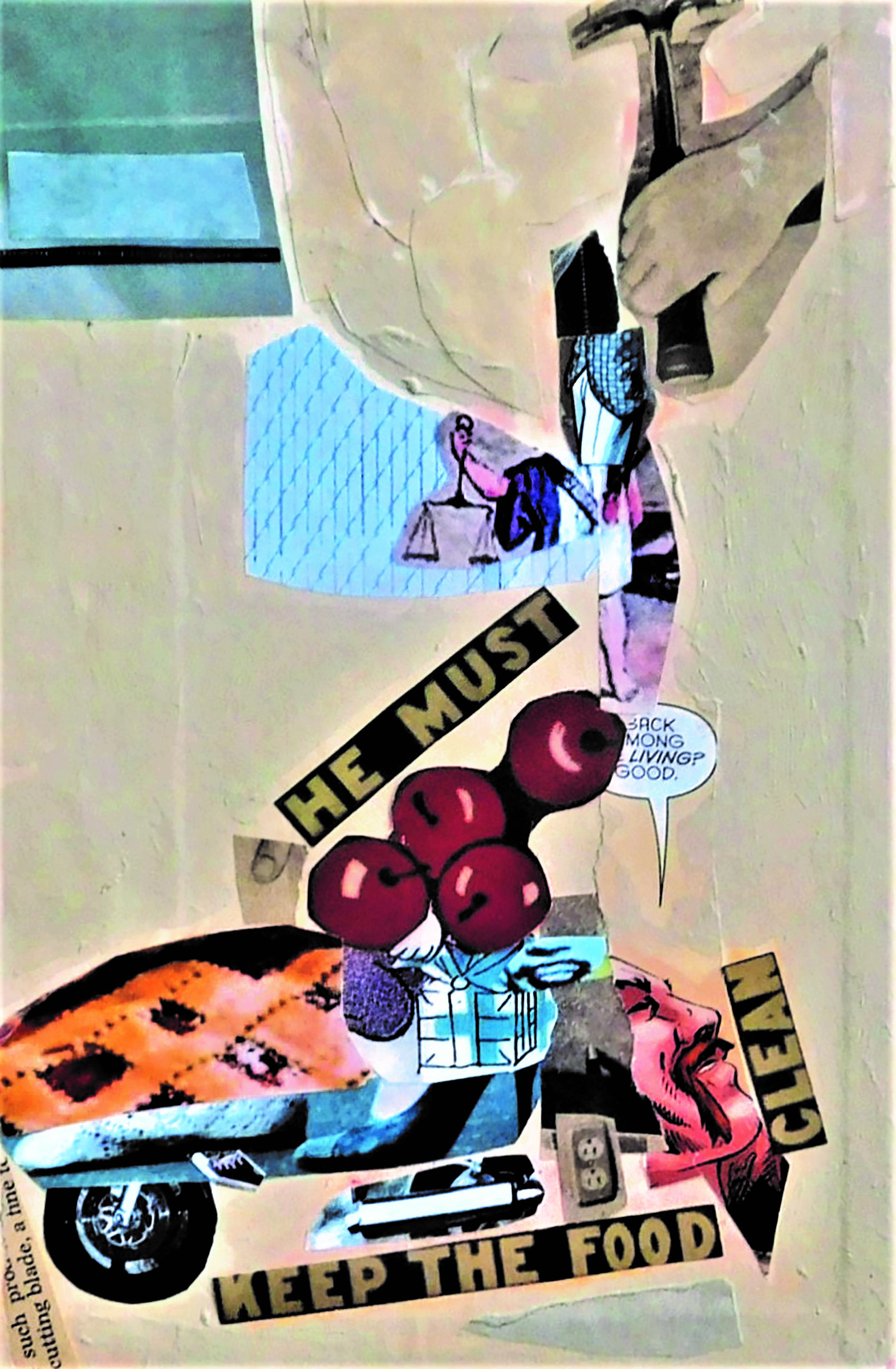
he must keep the food clean
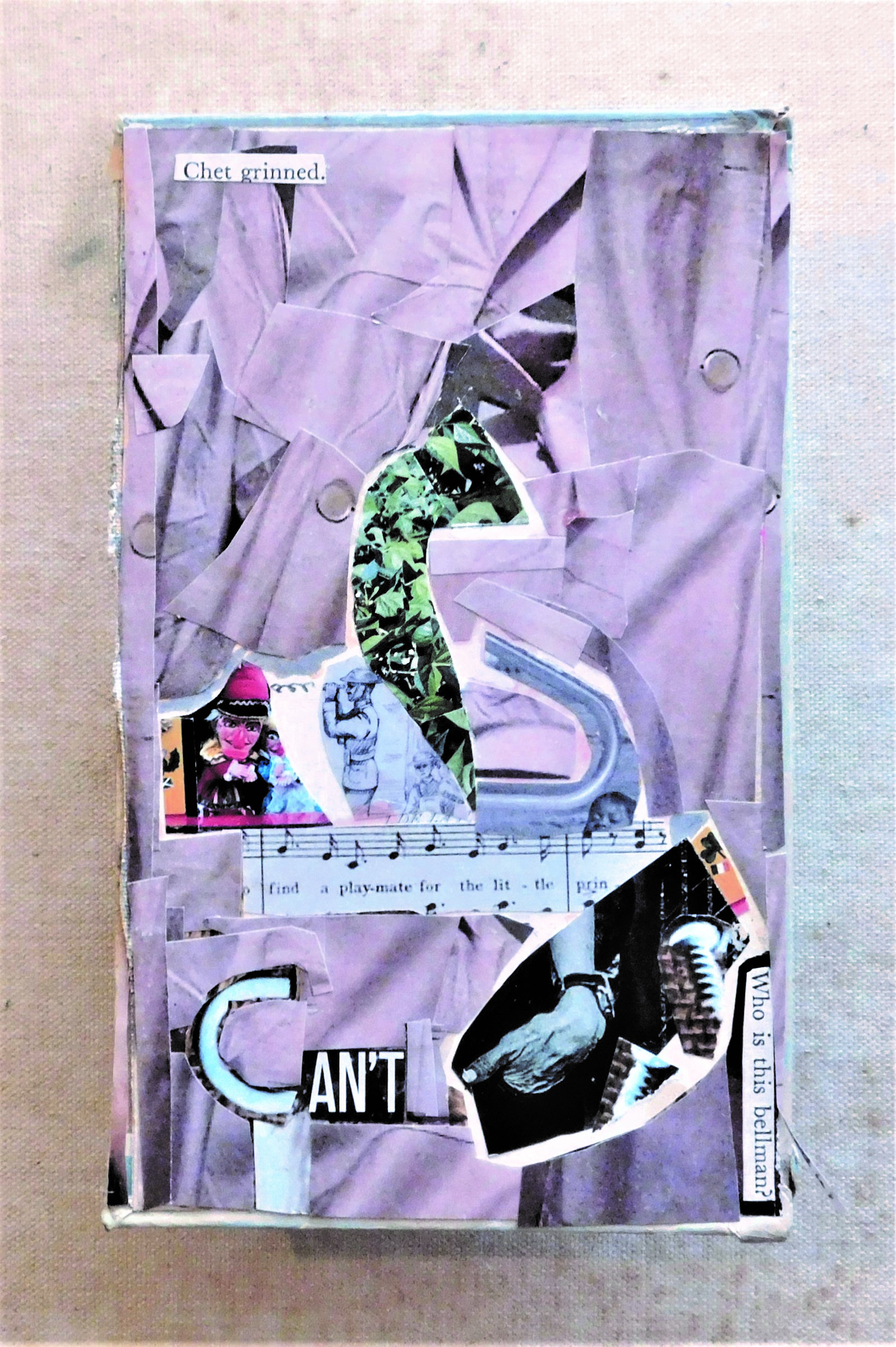
can’t
MF: You’re also a writer and a poet. We see some distinct interplay between words and images in these pieces, but how else do you see poetry influencing your visual art? (Or vice versa.)
DDL: I began as a visual artist. But even in my late teens I read the Beats, Rimbaud, Tom Robbins (yes, Tom Robbins), and I was very fond of Richard Brautigan, especially his epigrammatic poems full of ambiguity and metaphor. Hence, in college, I began appending very long titles to artworks, imagining the museum-goer’s surprise at confronting something such as “The Fruit Trees, beside Which the Gar Lives and Dreams Outside the Small Stream of Water that was Originally but is Only Now Sometimes Her Home” glued to the wall beside a large and primarily abstract—but for the suggestion of tree branches—oil painting (with the addition perhaps of a few objects affixed to the surface, such as string or a zipper or dried flowers). Anyway, the move into writing poetry felt natural to me. I was already used to assembling like and unlike things together, whether painted or appropriated, and making them live together as part of a formal work of art. The biggest challenge for me as an artist—poet or visual—has always been resisting the suggestion (by well-meaning friends and critics) that I make some sort of easy-to-access narrative or message available to the reader or viewer. Collage, though, by its very nature, encourages unlikely juxtapositions. By nature they are digressive . . . I love that about it. The point here being I don’t write poems or make visual art in order to emphasize already-existing ideas or narratives. These features may certainly be embedded in the fabric of the poem or artwork, especially as part of the dailiness of the poem, but my primary interest is in creating textures that bring a semblance of harmony to what’s absurd, banal, contradictory, or unpoetic.
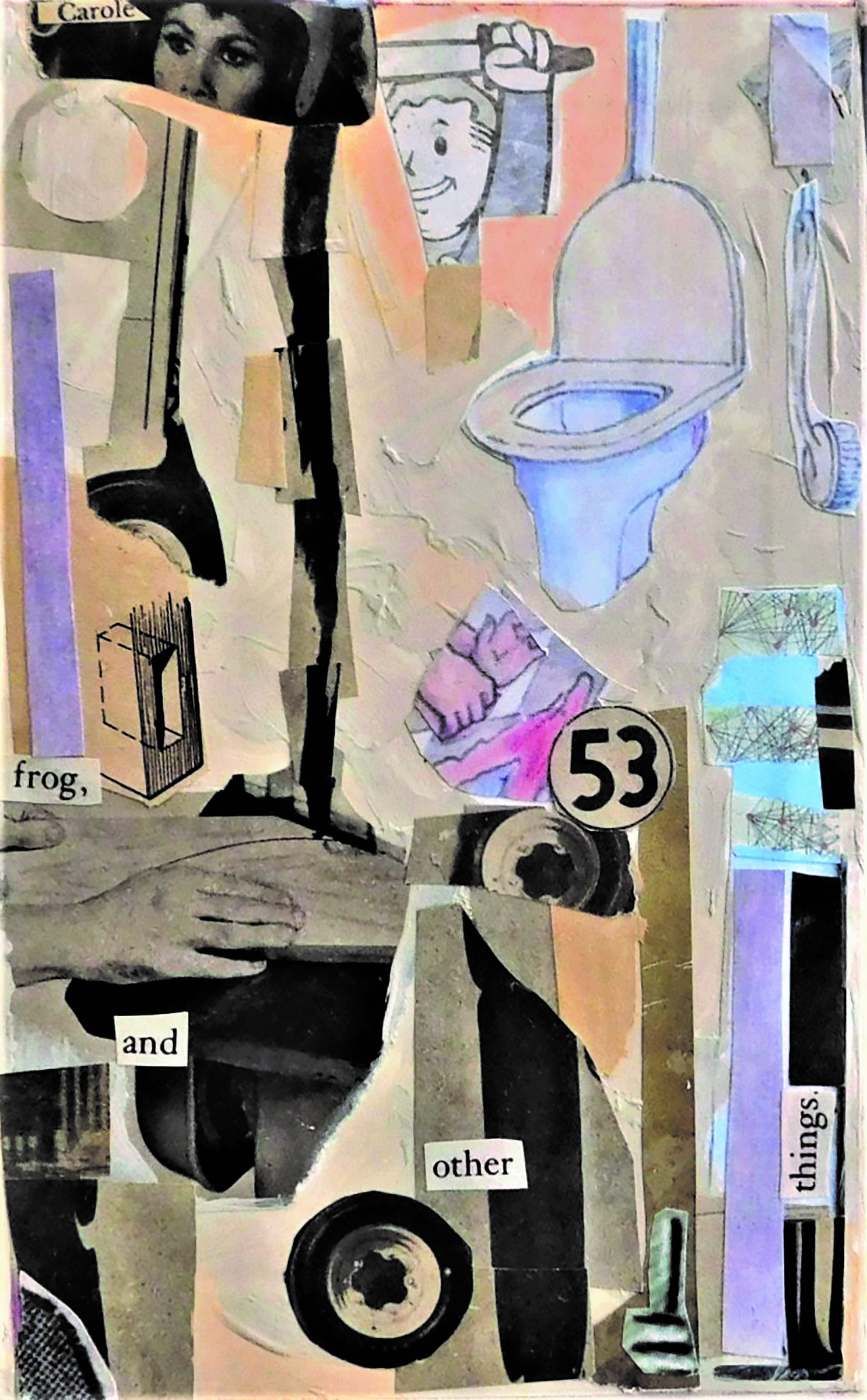
frog and other things
MF: We were really struck by some of the juxtapositions (image to image and image to word, and even juxtapositions in texture) in your collages, as well as the humor that comes from these juxtapositions. I’m thinking, in particular, of “He Must Keep the Food Clean.” Does humor play a role in your process?
DDL: Well, I mean, one of the reasons I make art and write is to amuse myself. Yes, I love finding, amidst so much cultural flotsam, suggestions of order, but I also love the ridiculousness rippling out of the vast concourses that comprise the seas of human noises we make. When I’m making art I’m playing, after all, and by “playing” I also mean being irresponsible. What’s more irresponsible than gluing an image of a toilet on the back of a hardback book cover along with some other fragments found hither and yon and then titling the thing “Frog and Other Things” as if I am presenting to the world my new book of short stories. “And other things”: as if anyone might know what these OTHER THINGS might be given the one known thing presented here is an amphibian. Can we assume these other things, then, might be lizards and salamanders? Or maybe a toilet, toilet brush or human hand, as represented alongside the words visually? Meanwhile, pieces of late-stage capitalism pepper my collage surfaces, including heavy doses of post-war imagery, when consumerism was the end all be all, without a trace of irony anywhere in sight. Radial tires were, like, to die for! At least, so say the ads in the Saturday Evening Post in the 1960s. This reaching back through time is especially apt now while we suffer through surviving (I hope) Donald Trump. One way to make fun of Trump is to make fun of the utter supremacy of Capitalism, which is what Trump represents as the highest of ideals. He would think nothing of throwing high quality toilet brushes (see Frog and Other Things) to a crowd of hurricane victims (as he did rolls of paper towels to same in Puerto Rico). This, to him, is what being an American is all about. In this manner, then, the collages present a kind of commentary. But they also critique our collective desire to find meaning in ABSOLUTELY everything. I mean, what is the significance of the number 53? I love the fact that some people will endeavor mightily to figure it all out. Just what is the meaning of the numeral 53? Is it related to Pizza Gate? Perhaps the Beatles’ Abbey Road album? There is no significance, of course. But it does make the collage look a little like a sleek race car (placed there as it is beside the two automobile tires and vague suggestions of racing stripes).
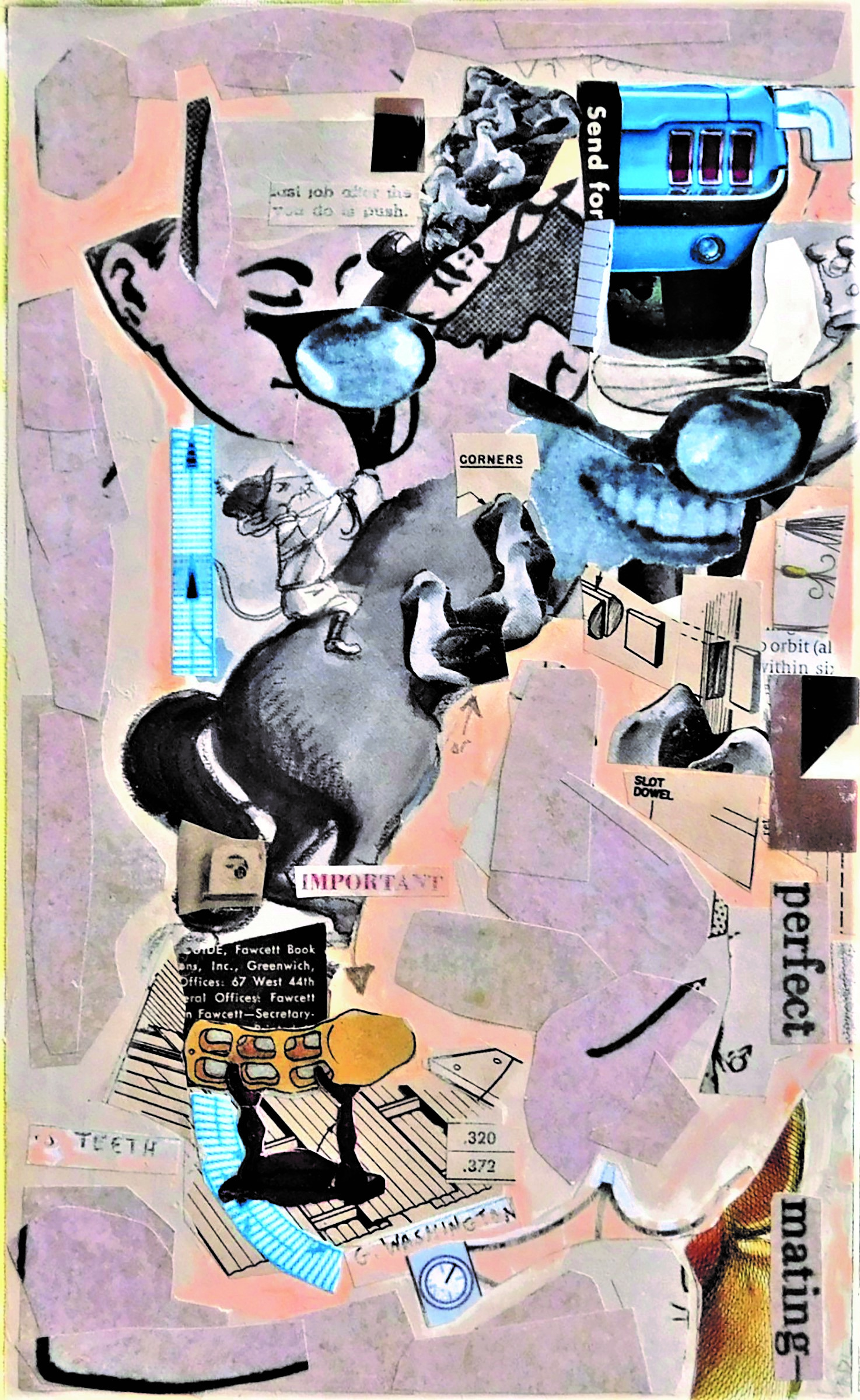
perfect
MF: Something that really struck me in your artist statement was how you talk about reality, specifically, “I like how chance introduces elements of the absurd and how the resulting juxtapositions suggest a reality I’m more familiar with than any contrivance an artist or poet might come up with.” Could you elaborate on the dialogue between art, reality, and absurdity?
DDL: I think I’ve already answered this to some extent. I just think that chance is a better arbiter of what IS than conscious choice, complete with biases, etc. I rarely sit down and say to myself, today I am going to make a collage about (fill in this blank with the idea of your choice), and then set about finding the images and words I might need to express myself thusly. I will say that part of my process includes feeding phrases into Google and then browsing through the images that pop up (I choose images that are labeled for reuse, fyi). If they stand out visually, are absurd enough, or just pique my interest at that moment, I print them. Sometimes the words I Google might be taken from poems of mine. Sometimes they are what I found when a piece of paper blew down a roadway upon which I was walking and stuck to my pant leg. I did Google “slinky” recently. Often the image I use bears no relation to the word I’ve Googled, however. I also have Tupperware tubs floor to ceiling stuffed with old books and magazines, comics, old mail, etc. All I know is the final arrangement of objects and words on the page are my preferred reality, something I have control over for one thing, as well as something that “talks back” to the culture at large.
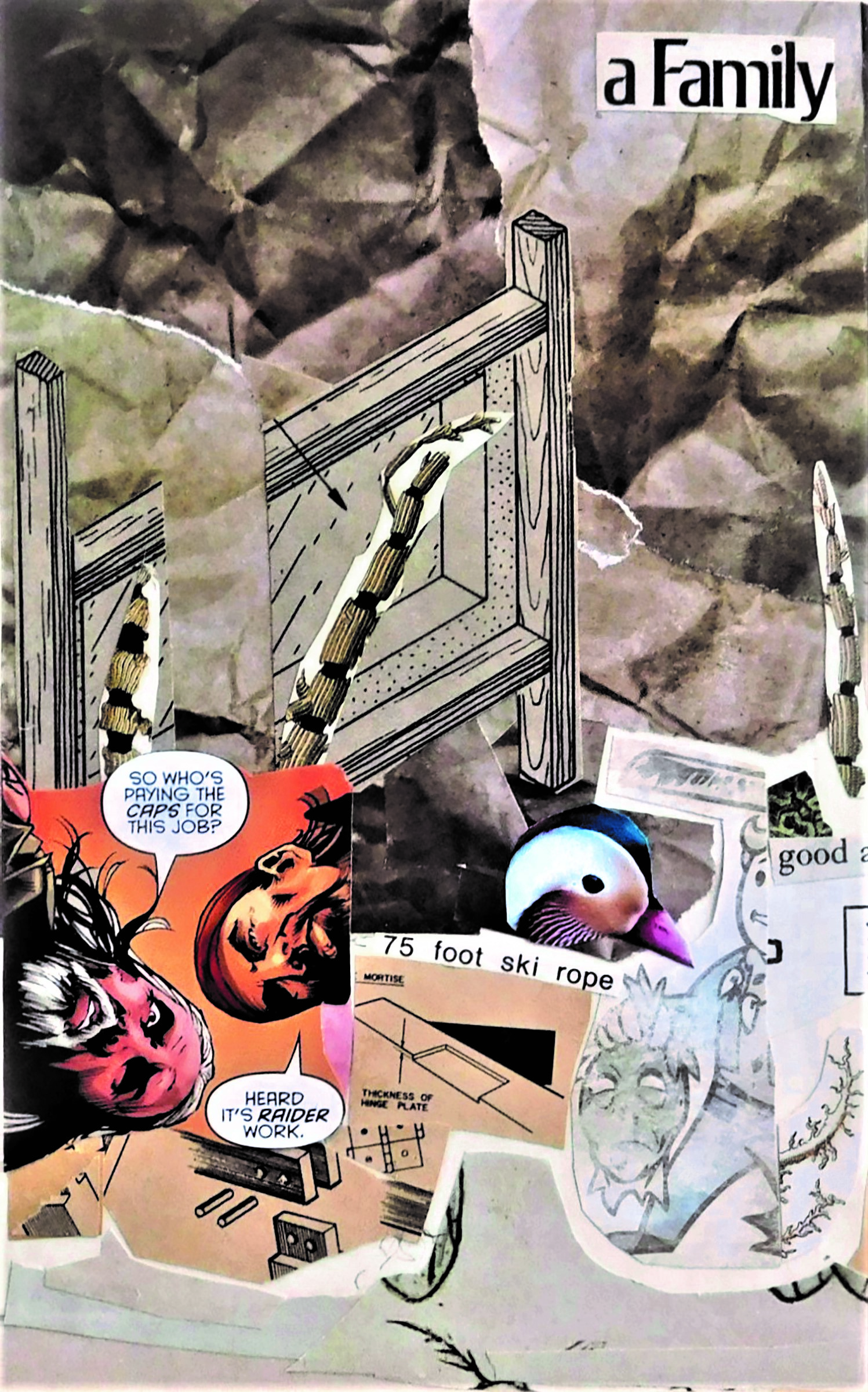
a family
Anyway, chance itself is a kind of intelligence. I made “He Must Keep the Food Clean” in 2019 and it seems to have predicted our necessary obsessiveness for cleanliness during this pandemic. If you want to dig further into my ideas having to do with art and absurdity, you might (if you feel like it) check out my book Orphan, Indiana, the poems within being what I based many of my earliest collages on. The resulting work (60 collages) was featured in an exhibition at Overbrook gallery in Muskegon, Michigan, in 2012.
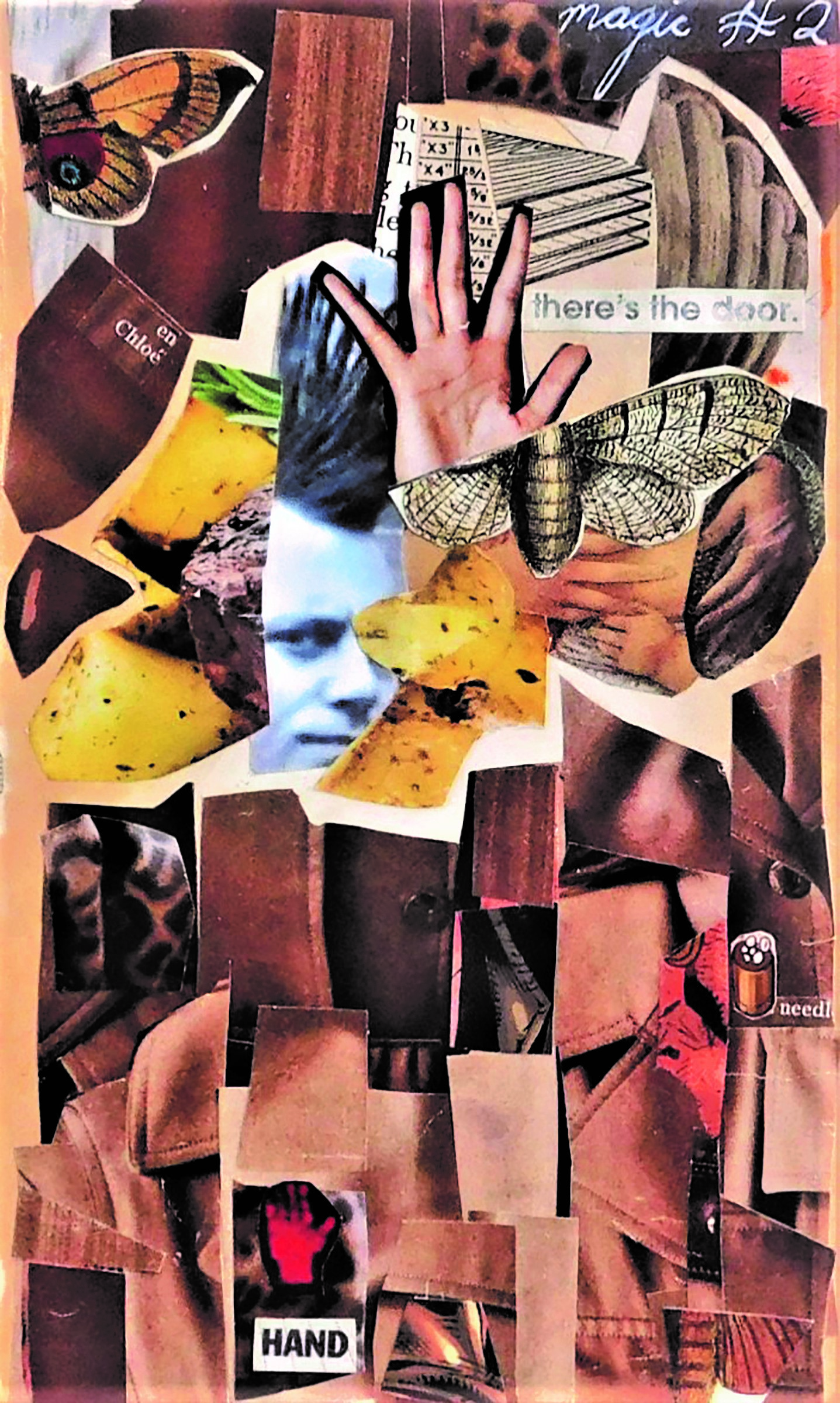
Magic #2
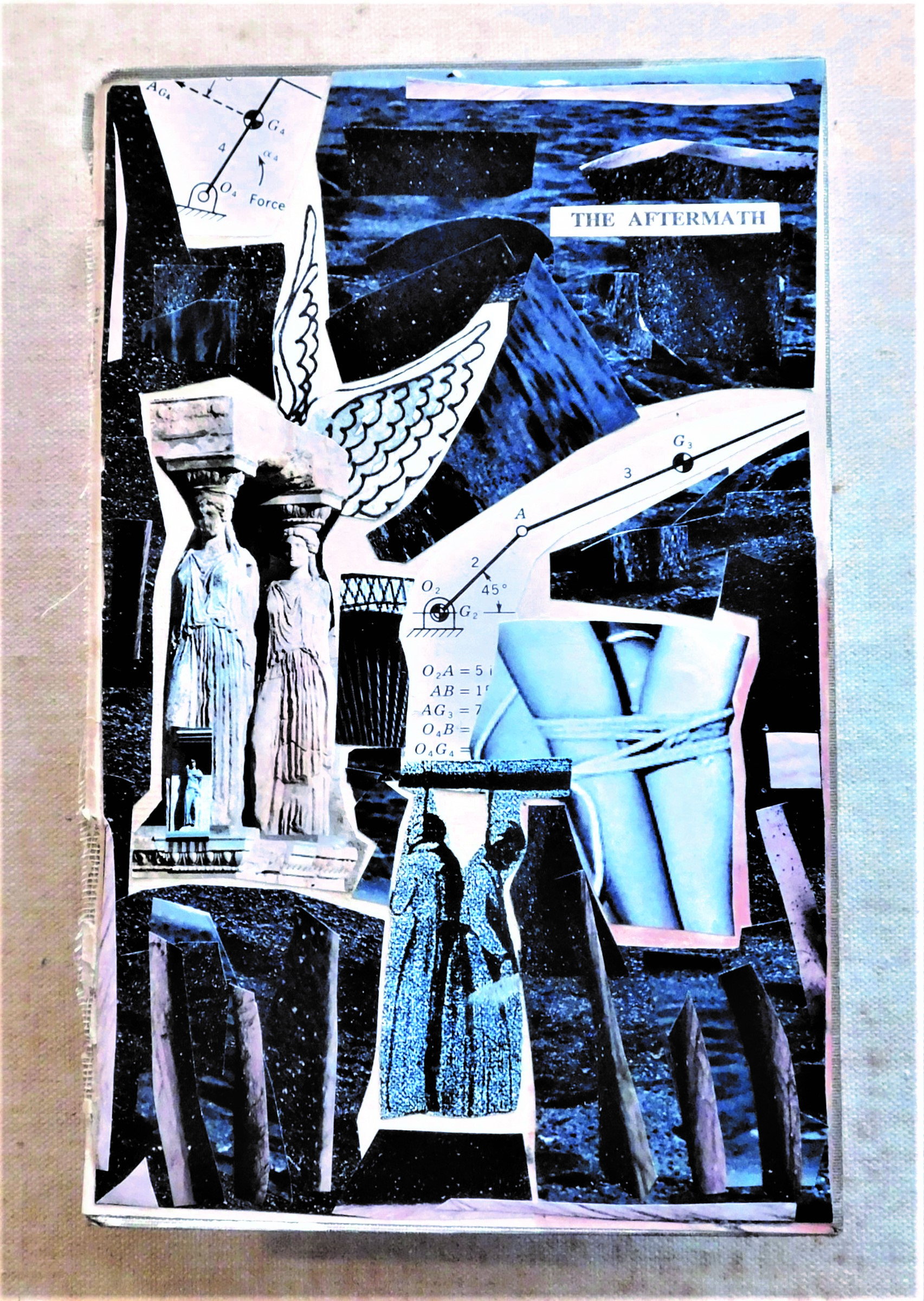
the aftermath
MF: Also in your artist statement you said, “Out of chaos comes order (hopefully),” which reminded me of a Witold Gombrowicz quote (from Cosmos, translated by Eric Mosbacher): “Born as we are out of chaos, why can we never establish contact with it? No sooner do we look at it than order, pattern, shape is born under our eyes.” While there’s something antithetical to these two quotes, they do seem to get to the nature of collage, where here we see literal order and chaos side-by-side. I think this also plays into the impulse to push back against ascribing narrative, and I was wondering if you could talk a little about that tension.
DDL: I agree wholeheartedly with what you are getting at here. And I’m a bit abashed that I suggested “out of chaos comes order (hopefully)” because I don’t really care that much. Better to say, my art is an act of funneling chaos. Hopefully someone will enjoy looking at it. It’s true though that in taking what’s disparate and worldly and heaving it all together the collage artist is boldly suggesting that order is predominant in our universe, since the very act of collecting and then assembling it (and therefore suggesting there is value in this act) attests to the idea that such is true. I suppose one could say the artist in this instance TAMES reality by imposing order, but I prefer the boldness of daring to present what’s incomplete and chaotic. I do like collages that flirt around the edges of chaos and accept the idea that it is there, and that we’d better just get used to it. I also like the idea of letting the materials themselves have their say, of the artist not getting too much in their way. To this end I like what Gerhard Richter has called somewhere, in reference to art-making and craft, “the dazzlement of skill.” Give the components of your collage, which are pieces of reality, their own free rein, and let them exist jaggedly beside one another, as they will. Don’t interfere too much with your own manipulation of what’s already interesting. This idea, of course, of one being merely a facilitator of organized chaos, is partly a ruse, since one is, after all, engaged in the process of arranging and ordering, an interloper who has entered the stream of reality. (It’s all paradox!) It is the artist who is making decisions—placing a form here, deciding on torn edges rather than the more orderly scissored ones, etc. The artist is forever making associations, compiling, presenting one of many realities to the world. I guess, ideally, I would like to believe I am simply collaborating with what already is . . .
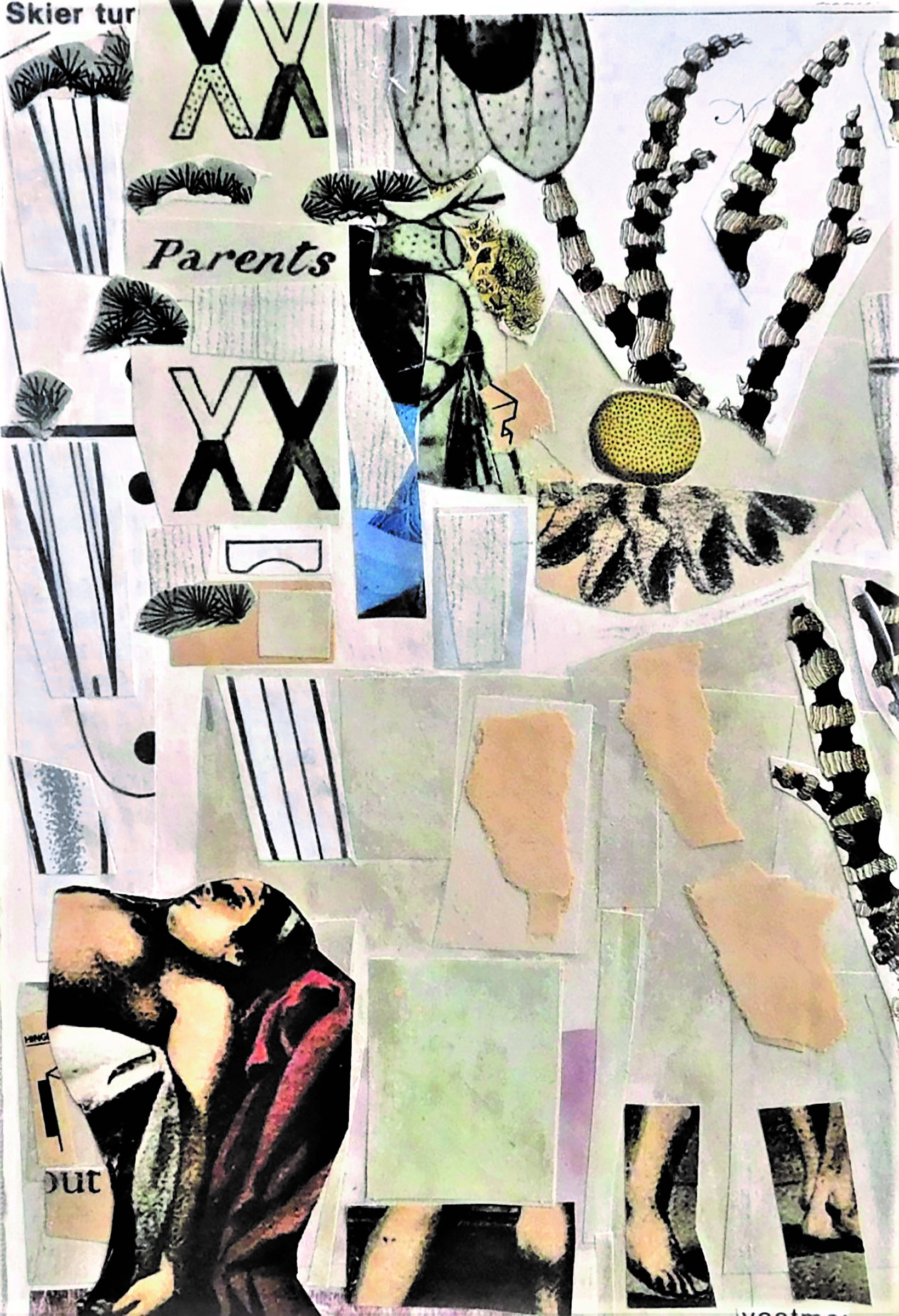
parents XX
MF: Do you have any other projects coming up?
DDL: Dangerous question, as I have already gone long here. I have a book of collages and photographs and erasures and dictionary sonnets and a few original poems whose release has been slightly delayed by the pandemic (it’s called Unlucky Animals). I have an exhibit or two in the works. Plus I’m completing a book of fiction—stories and a novella. I’ve also completed three new manuscripts of poems I have to place. Let’s see what the future holds. I’ll know more when we get through the election successfully without becoming engaged in some sort of civil war, and we’ve gotten to the other side of this health crisis. Right now I just keep making art and writing. I’m going to try to survive the semester as well, feeling already quite Zoomed out. Making art does help keep me sane.
David Dodd Lee is the author of nine full-length books of poems & a chapbook, including Downsides of Fish Culture (New Issues Press, 1997), Arrow Pointing North (Four Way Books, 2002), Abrupt Rural (New Issues Press, 2004), Orphan, Indiana (University of Akron Press, 2010), Animalities (Four Way Books, 2014), and two volumes of Ashbery erasure poems. He has published fiction in Willow Springs, New World Writing, Sou’wester, Green Mountains Review, and elsewhere. He is also a painter and a collage artist, who often exhibits his work in galleries in the U.S. Recent artwork has also appeared in Tupelo Quarterly, Permafrost, The Hunger, Pinball, & Twyckenham Notes. He provides illustrations for essays and fiction regularly at The Rumpus. In 2016 he began making sculpture, most of which he installs on various public lands, surreptitiously. Unlucky Animals, a book of collages, photographs, several long original poems, erasures, and dictionary sonnets is forthcoming in early 2021. He is Associate Professor of English at Indiana University South Bend where he is also Editor-in-Chief of 42 Miles Press.
He has been posting work on Instagram since October, 2019 at instagram.com/davidlee2588. Older work appears at Seventeenfingeredpoetrybird.blogspot.com
